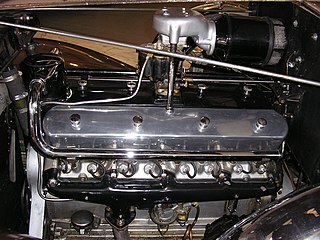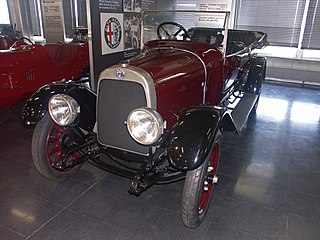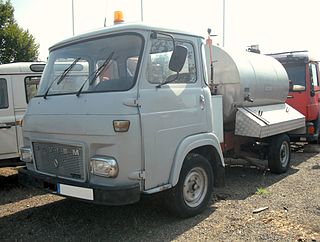Related Research Articles

A V12 engine is a twelve-cylinder piston engine where two banks of six cylinders are arranged in a V configuration around a common crankshaft. V12 engines are more common than V10 engines. However, they are less common than V8 engines.

A V16 engine is a sixteen-cylinder piston engine where two banks of eight cylinders are arranged in a V configuration around a common crankshaft. V16 engines are less common than engines with fewer cylinders, such as V8 and V12 engines.

A straight-four engine is a four-cylinder piston engine where cylinders are arranged in a line along a common crankshaft.

The straight-six engine is an internal combustion engine, with six cylinders mounted in a straight line along the crankcase with all the pistons driving a common crankshaft.

Commer was a British manufacturer of commercial vehicles from 1905 until 1979. Commer vehicles included car-derived vans, light vans, medium to heavy commercial trucks, military vehicles and buses. The company also designed and built some of its own diesel engines for its heavy commercial vehicles.

The Ferrari Colombo Engine was a petrol fueled, water cooled, carburetted 60° V12 engine designed by Gioacchino Colombo and produced in numerous iterations by Italian automaker Ferrari between 1947 and 1988. The maker's first homegrown engine, its linear successor is the Lampredi V12, which it far outlived, the last Lampredi being made in 1959.
Multijet is Fiat Chrysler Automobiles' term for its current common rail direct injection turbodiesel engine range. Most of the Fiat, Alfa Romeo, Lancia range as well as certain Chrysler, RAM Trucks, Jeep and Maserati vehicles are equipped with Multijet engines. Ownership of some Fiat Multijet designs is shared with General Motors as part of a settlement of the failed merger between the two auto conglomerates. GM Powertrain Torino group in Turin, Italy manages their interest in these engines. Some PSA Peugeot Citroën diesel engines are also rebadged JTD units, and vice versa. Fiat's common rail diesel engine is also known as JTD, an initialism of Jet Turbo Diesel.

The Alfa Romeo V6 engine was a 60° V6 engine made by Alfa Romeo from 1979 to 2005. It was developed in the early 1970s by Giuseppe Busso, and used on the Alfa 6 with a displacement of 2.5 L (2,492 cc) and a SOHC 12-valve cylinder head. Later versions ranged from 1,997 to 3,195 cc and had DOHC 24-valve valvetrains. The original design had short pushrods for the exhaust valves in a design similar to earlier Lancia Fulvia engines. The first DOHC version was in the 1993 Alfa Romeo 164, with an aluminium alloy engine block and head with sodium filled exhaust valves.
The 8140 was a diesel engine made by Sofim for automobiles. Originally introduced as a swirl chamber, naturally aspirated diesel it was mostly used in commercial vehicles worldwide.

ALFA or later Alfa Romeo has made three cars named as 20/30 HP, first one 1910 4-cylinder 4-6-seater tourer, improved version 20/30 HP E in 1914 and 1921 the 20/30 HP ES Sport, a 4-seater sportscar.

A V8 engine is an eight-cylinder piston engine in which two banks of four cylinders share a common crankshaft and are arranged in a V configuration.

The Alfa Romeo Romeo was a light commercial, cabover van and pickup truck that was introduced by the Italian automaker Alfa Romeo in 1954 as the Alfa Romeo Autotutto. The line of vans continued to be built until 1983, when it was replaced by relabelled Fiat and Iveco commercials.

The Alfa Romeo 800 is an Italian heavy truck produced by Alfa Romeo between 1940 and 1947. It was first produced as a military version 800RE and after the war as a civilian version. The military version was initially used only in the Italian Army, mainly in North Africa, Russia and occupied France. The 800 was equipped with an 8.7 L diesel engine and could reach a top speed of 50 kilometres per hour (31 mph). There were also gas generator and gasoline models produced. A half track prototype version a CSEM 800RE was also made for Italian army. Some of 800RE were also converted to German Army as Maultier, this vehicle had also tracks in rear.

The Alfa Romeo 500 is a 3 tonne class truck, produced by Alfa Romeo from 1937 to 1945. The range included a diesel-powered 75 hp (56 kW) version 500RE, petrol version 500B and gas version 500BR.
The Alfa Romeo Mille is an eight-ton forward control lorry produced by Alfa Romeo between 1958 and 1964. It was the last Alfa Romeo heavy commercial vehicle.
Sofim is a joint diesel engine enterprise established between Fiat, Saviem (Renault) and Alfa Romeo on 13 September 1974 and was bought by Iveco in 1981. The manufacturing plant is located in Foggia in southern Italy and is nowadays Fiat Powertrain Technologies largest engine plant covering an area of approximately 540,000 square metres (5,800,000 sq ft).

The Alfa Romeo 85 is a truck produced by Alfa Romeo between 1934 and 1939, it was an updated version of licensed Büssing model.

Alfa Romeo 350 is a medium Italian truck produced by Alfa Romeo in its Portello Plant. It was made after the 85 and 110 proved to be too heavy and expensive.

The Renault Super Goélette is a van from the small commercial vehicle range manufactured by Saviem and marketed by Renault from 1965 to 1970, then from 1971 to 1980 by Saviem and finally by Renault Véhicules Industriels (RVI) between 1980 and 1982.
References
- ↑ Trucksplanet: Alfa Romeo A15 / A19 / A38 / F20 (Commercial vehicles) - Trucksplanet, accessdate: 4. August 2017
- ↑ l'automobile ancienne: Man Meccanica, accessdate: 4. August 2017